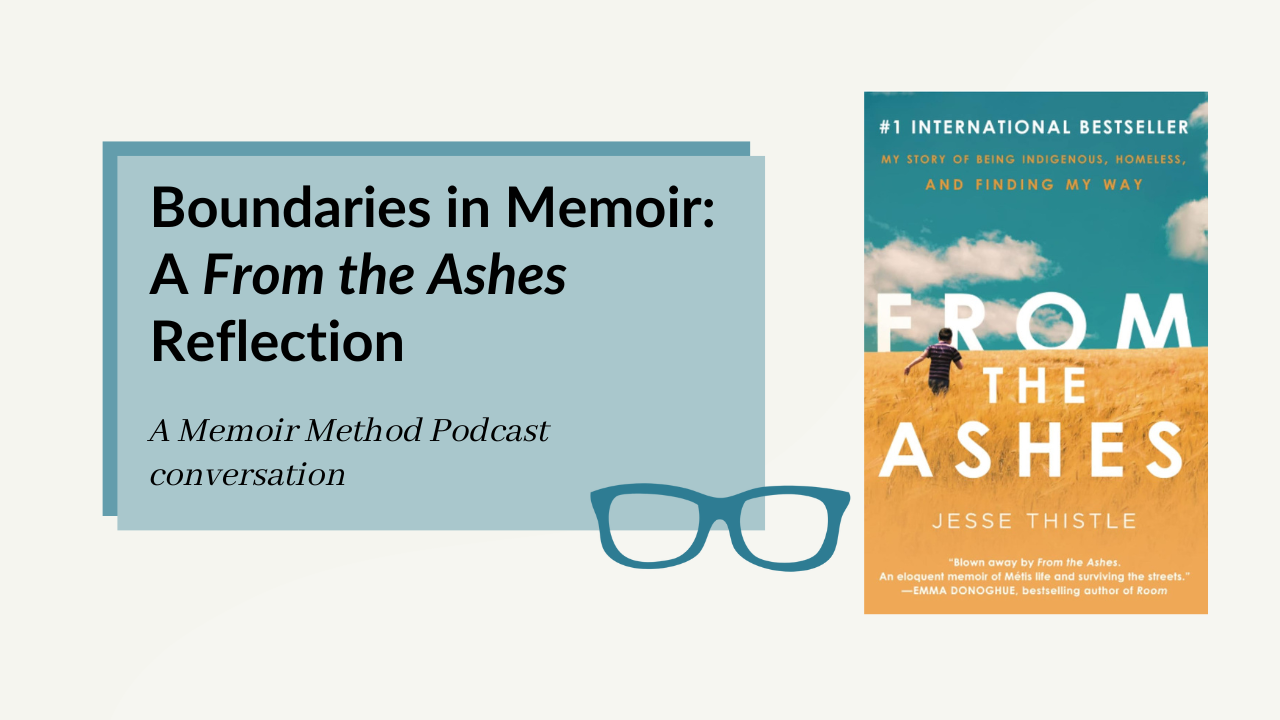Boundaries in Memoir: A From the Ashes Reflection
Writers can fall into this misconception that if you’re going to write your memoir you’re honor-bound to spare no detail and give everything to your reader. I’ve heard variations on the thought, “But I need to be truthful!” Here’s the real truth, though: If you’re writing for a reader, then you owe them connection, not everything. And you get to decide where the line is.
What boundaries in memoir look like
In Jesse Thistle’s memoir, From the Ashes, we’re invited into an excruciating three decades of Thistle’s life, where he shares some of the most devastating moments and experiences of his life. He does this in a way that’s personal and somber; Thistle is trusting his reader to honor his story as he chooses to share it. This memoir went on to become a Canada Reads book in 2020, and in the four years since its publication, From the Ashes has brought Thistle into the spotlight over and over again.
Now? He’s finished giving interviews and publicly discussing his book. He’s given all he can to this story and is ready to move on and heal. He has said what he needs to say and trusts his readers to respect his story and honor him as a person. Because the truth about memoir? It’s impossible to separate the person from the writer. If we’re going to wade into a memoir, we need to be prepared to witness whatever the author is willing to share.
How to set your own boundaries as a writer
As you start the writing process, consider two primary elements: 1) why you’re writing and 2) who you’re writing for. Knowing these answers will help you know if you’re even ready to write for a reader yet. If you’re writing for an outside reader, you’ll need to be prepared for vulnerability and what may feel like over-sharing. You need to pull out the threads of your story that will most forge connection and keep your reader invested.
That said, you still get to decide how much to share. (Because you don’t need to share everything to still share the truth.) Remember that your ultimate purpose in writing your memoir is to connect, and identifying what belongs in your memoir and what you can keep to yourself will be easier.
You’ll probably have readers or others in your life who will demand more. But remember this: You owe them nothing. You actually don’t owe your reader anything. Memoir readers are distinct in that they enter the reading experience with an unspoken, nuanced contract with the writer that says, “I’m here to receive whatever it is you’re willing to give.” The reader-author relationship is uniquely trust-driven, and when you come at writing through that lens, you’ll better know what to share and where to hold back. Your right reader will resonate with whatever you share.
Navigating open vulnerability
If you are an author writing for a reader, you’ll need to be prepared for talking about your experience over and over again. Most publishing marketing is on the shoulders of the author, and to promote your book—regardless of whether you publish traditionally or self-publish—you’ll need to be ready to talk about your book a lot.
This means that you’ll need some level of healthy detachment from your topic and the ability to talk about the same events and experiences over and over again. Establish a system of self-care that gives you time to recover and rest and reset your mind-body connection. After you’ve completed your end of a publishing contract or marketing plan, you can start to decide where your boundary is with further discussions about your memoir.
Are you able to continue discussing this with the public? Do you want to?
What boundary do you want to hold? Who can help you hold it?
Do you have enough resources out there to support the message of your memoir for readers who come across your story after you’ve finished the live marketing events?
You don’t have to have all these answers right now, but you won’t regret letting these questions simmer in the back of your mind.
What you can do now
If you’re in the middle of the writing, you don’t have to decide yet what your boundaries are—but do know that you’re allowed to have them. Read other memoirs (like Jesse Thistle’s From the Ashes) and get a feel for how they navigate their own vulnerability and points of connection with the reader.
Right now, lead with connection. Trust your reader, and just write.
You’ve got this.
If you liked this post, you’ll enjoy podcast episode 14 of the Memoir Method Podcast, where Ginny Walters and I reflect on our experience reading From the Ashes and what we learned from Jesse Thistle’s vulnerability and writing.
You might be wondering if writing a memoir is the right move for you. If that’s the case, go and download my free ebook Should I Write a Memoir. This resource will guide you through an introspective process that will give you the clarity you need in your writing.
You can find more posts and conversations about From the Ashes here.


